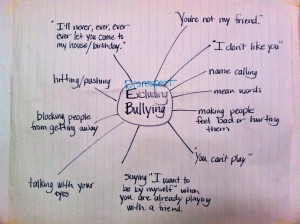 What I love about the Seed is the way the teachers and children go after problems when they arise. While we strive to create a community of inclusion and kindness, from time to time we need to remind ourselves of what that looks like at school. Last week our three older classes took on bullying and exclusion. Rather than giving children a top-down set of do’s and don’ts, the group set out to identify the problem, organize the assorted behaviors into categories, and then lay out a plan for eliminating future issues around exclusion. The teachers furthered the children’s thinking by reading a story about name calling, role playing examples of how children are left out, drawing webs, making lists, and coming up with a chart with key points for successful interactions. The level of precision in applying certain terms, such as “private talk,” was impressive. For example, the group talked about what a private conversation is, when it’s appropriate to talk privately, and why it’s not acceptable to say “We’re having a private talk” when in reality the intention is to exclude someone. Although there was still work to do when the meeting ended, each class walked away with at least a few ideas for their personalized list of guidelines for improving the quality of playground relationships. By the end of the week we had a list of problems with specific examples, and a completed list of guidelines that were published on each of the elementary classroom websites.
What I love about the Seed is the way the teachers and children go after problems when they arise. While we strive to create a community of inclusion and kindness, from time to time we need to remind ourselves of what that looks like at school. Last week our three older classes took on bullying and exclusion. Rather than giving children a top-down set of do’s and don’ts, the group set out to identify the problem, organize the assorted behaviors into categories, and then lay out a plan for eliminating future issues around exclusion. The teachers furthered the children’s thinking by reading a story about name calling, role playing examples of how children are left out, drawing webs, making lists, and coming up with a chart with key points for successful interactions. The level of precision in applying certain terms, such as “private talk,” was impressive. For example, the group talked about what a private conversation is, when it’s appropriate to talk privately, and why it’s not acceptable to say “We’re having a private talk” when in reality the intention is to exclude someone. Although there was still work to do when the meeting ended, each class walked away with at least a few ideas for their personalized list of guidelines for improving the quality of playground relationships. By the end of the week we had a list of problems with specific examples, and a completed list of guidelines that were published on each of the elementary classroom websites.
Our work with relationships at the Seed has a long history, influenced largely by Vivian Paley’s book, You Can’t Say You Can’t Play. Paley interviewed school children to gather their perspectives on exclusion from play. Not surprisingly, she found that children in power tended to believe that exclusion was acceptable, while those less empowered thought it was wrong. She made a strong case for the importance of teachers being advocates for children who are left out and added that if we don’t stand up for the children who are being excluded (and give them the tools to do this for themselves), who will?
Since we’re all human beings, still learning how to be with each other on the planet, we continue to have lessons to learn. I’m grateful personally, and on behalf of the children who attend the Seed, to be surrounded by teachers who not only provide support and solutions, but model powerful, effective means of solving problems as they come up. My guess is that the Seed will keep adding to the earth’s collection of wise, compassionate leaders, thanks to their mindful and caring teachers.
